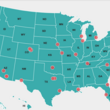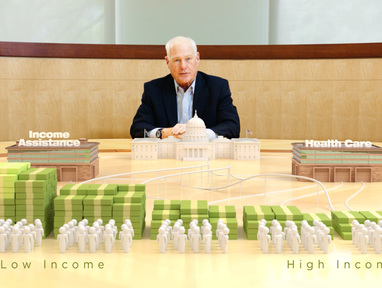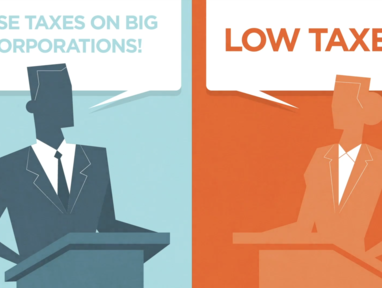Thinking about Long-Term Debt

Whether you are watching the evening news or scrolling your social media feed, it is clear that few people are focused on the long run. It is not surprising. Between a pandemic, high unemployment, and a tense election, there seems to plenty to worry about today. Nevertheless, while our shortsightedness is understandable, it is probably not advisable.
A focus only on immediate issues will leave us unprepared for the future. That’s particularly true when it comes to federal and state budgets. Whether they’re overlooking skyrocketing federal debt or unfunded state pension obligations, lawmakers continue to make short-run budget decisions that will disproportionately burden future generations.
How big are these problems, and are there any good solutions?
What is the long-term outlook for the federal budget?
The pandemic and its legislative response exacerbated an already dire budget outlook. The 2020 federal deficit was already projected to exceed $1 trillion before lawmakers added $2 trillion in new borrowing to fund COVID-19 economic relief packages. The consequences for the long-term budget from this spending is significant. Last year, the Congressional Budget Office projected federal debt held by the public to rise from 79 percent of GDP in 2019 to 144 percent in thirty years. Just over a year later, however, debt now exceeds 100 percent of GDP and is projected to grow to 195 percent by 2050.
While COVID-19 and the related response by Congress increased the nation’s debt levels, the future debt will still be driven by massive future spending increases. Over the next thirty years, federal spending is projected to rise from 21 percent of GDP to 31.2 percent. Meanwhile, taxes will only rise from 16.3 percent to 18.6 percent of GDP. The result will be growing deficits that exceed 10 percent of the nation’s economy.
As we noted in last year’s Policy Insights edition on the debt, the increased spending is driven by a mere handful of government programs, specifically: Medicare, Medicaid, and Social Security. In 2019, those programs accounted for just over half of government programmatic spending. By 2050, they will account for more than two-thirds. In the video below, economist John Cogan explains why these programs are expanding:
You can see the gory budget math in the Hoover Institution’s America Off Balance Budget Calculator. The calculator analyzes the budget over the next thirty years and shows the effects of various budget reforms.
Why should we be concerned about the federal debt?
Increases in the federal debt might not concern you too much right now. Interest rates are near all-time lows, so paying for the borrowing is relatively inexpensive today. But over the long term, out-of-control debt threatens to destabilize the economy and destroy future economic opportunities.
Economist John Cochrane discusses the possible consequences of the higher federal debt in his blog the Grumpy Economist. He notes that as debt rises, the United States is more at risk of a debt crisis where lenders to the federal government become unwilling to finance the debt. The risks may seem small now—investors are currently eager to buy US Treasury Bonds—but Cochrane explains how this might change in the future:
At this point, the US has, say, 150% debt to GDP. It needs to borrow another $5–$10 trillion, or get people to hold that much more newly printed money, to bail out once again, and pay everyone’s bills for a while. It will need another $10 trillion or so to roll over maturity debt. At some point bond investors see the end coming, as they did for Greece, and refuse. Not only must the US then inflate or default, but the firehose of debt relief, bailout, and stimulus that everyone expects is absent, together with our capacity for military or public health spending to meet the shock that sparks the crisis.
Even beyond a debt crisis, rising deficits will have economic consequences. Government borrowing requires that someone lend money. It might come from foreign buyers of the debt or from the Federal Reserve. Or, it might come from investors who would have otherwise invested in someone’s business or invention. Economists call this “crowding out.” It happens where money is lent to the federal government that would have been directed to entrepreneurs to create or expand their business. The result is less private investment, which will ultimately reduce economic growth.
Economist Michael Boskin examines the economic effects of the debt in his paper “Are Large Deficits and Debt Dangerous?” He explains that “to the extent deficits decrease national saving and crowd out investment, incomes, especially wages, will be lower than they would have been in the future.”
What about state budgets?
While attention is often focused on the federal budget, states are not paragons of sound finances either. In an interview regarding the nation’s debt, John Cochrane reminds us it isn’t just the federal government that faces large budget challenges. State and local governments “have borrowed an enormous amount of money that they have no idea how to pay back.” The cause of most states’ budget problems is similar to the federal government’s budget issues; namely, policy makers have promised more than they’re requiring citizens to pay.
The problem of overpromising is particularly noticeable when it comes to unfunded state and local government pension obligations, which total at least $4 trillion. In a detailed report, economist Joshua D. Rauh explains that state and local governments have refused to make adequate contributions to their pension funds:
While total government employer contributions to pension systems were $111 billion in 2015, or 4.9 percent of state and local government revenue, the true annual cost of keeping pension liabilities from rising would be approximately $289 billion or 12.7 percent of revenue. Applying the principles of financial economics reveals that states have large hidden unfunded liabilities and continue to run substantial hidden deficits by means of their pension systems.
The pension problem isn’t happening in just selected cities and states. PolicyEd’s Pension Pursuit shows how widespread the problem is in this interactive map:
Like their federal counterparts, state and local government lawmakers typically refuse to acknowledge a significant problem exists. Watch this video to learn how these policy makers are avoiding difficult decisions today:
The economic risks from these underfunded pensions are just as dangerous as the federal government’s unprecedented borrowing. The specific danger is that underfunded pensions force states to raise taxes to balance their budgets, as most states are required to do. This danger isn’t hypothetical. In the wake of the COVID-19 pandemic, as state governments are facing large shortfalls in their budgets, some states have quickly looked to tax increases to shore-up these shortfalls. Rauh covers California’s tax increase proposals in this recent op-ed. While the current budget challenges are not a direct consequence of the underfunded pensions, the reaction by state lawmakers to look tax hikes to solve these budget challenges is emblematic of how future pension issues will be resolved.
Can’t we just raise tax rates?
For many the answer to all this debt is obvious: we should raise tax rates. But there are good reasons to think that increasing revenue in this fashion is not a panacea to our debt crisis.
First, the size of the problem means that we would need substantial rate hikes. How much? The America Off Balance Budget Calculator estimates that we would need to raise taxes by more than 16 percent just to keep federal debt at or below 100 percent of GDP. If you tried to raise all that revenue by only raising taxes on high-income taxpayers, you would need much larger rate increases that would push marginal income tax rates far beyond 50 percent.
Tax increases may help reduce debt levels, but increasing tax rates would have significant side effects. The video below explains how high tax rates give individuals fewer reasons to work, save, and invest. The economic effects from these tax increases can be great. Economist Michael Boskin has estimated that an additional dollar of revenue from high tax rates “costs the economy about $1.40.”
And even beyond the effect on the economy, the higher tax rates won’t necessarily deliver the revenue need to improve our budget picture. As Joshua Rauh covers in the above op-ed, California has tried this strategy in the past, and several California lawmakers appear eager to try it again. Rauh shows, however, that this strategy isn’t guaranteed to raise much revenue. High taxes lead people to change their behavior in ways that reduce taxable income. Rauh has noted that past California tax hikes have encouraged high-income Californians to flee the state or alter their income flows to avoid the high taxes.
Conclusion
So what is the answer? As we explained above, our budget problems stem from too much spending. Whether in the form of state pensions or federal entitlement programs such as Social Security or Medicare, politicians have made promises that will be hard—or impossible—to keep. Here is John Cogan again discussing the extent of our federal budget problems:
As Cogan explains, this isn’t the first time that increased Social Security spending has required action. President Carter and a bipartisan contingent in Congress reformed Social Security benefits in the 1970s when it became clear that the trajectory had become unsustainable. That doesn’t mean that fixing our federal entitlement programs or public pension systems will be easy. It will require bold actions by policy makers and the demands of an electorate that is weary of our shortsighted budget policies.
Citations and Additional Reading:
A new theory, called Modern Monetary Theory, argues that permanent deficits aren’t as dangerous as you think. John Cochrane explains the numerous shortcomings with the theory.
John Cogan, Daniel Heil, and John Taylor estimate the positive effects of debt reduction in this paper. They find that reducing debt to its 2019 levels would eventually increase the size of the economy by about 7 percent.
Economist David Henderson argues that state and local governments shouldn’t receive federal bailouts. While state and local lawmakers are quick to blame COVID-19 for their current budget issues, Henderson notes that their budget problems are a consequence of years of profligate state spending.


















